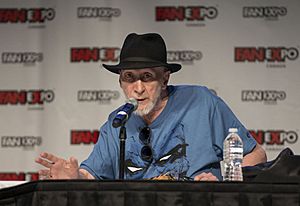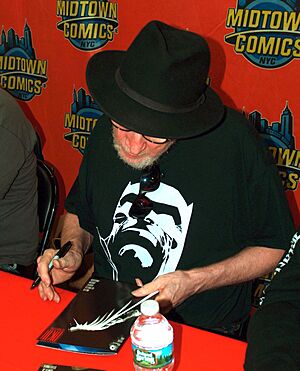Frank Miller facts for kids
Quick facts for kids Frank Miller |
|
|---|---|
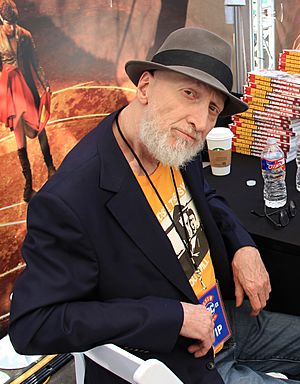
Miller at SXSW 2018
|
|
| Born | January 27, 1957 Olney, Maryland, U.S. |
| Area(s) |
|
|
Notable works
|
|
| frankmillerink.com | |
Frank Miller (born January 27, 1957) is a famous American comic book artist, writer, and film director. He is well-known for creating popular comic book stories and graphic novels. Some of his most famous works include Daredevil, where he created the character Elektra. He also worked on The Dark Knight Returns, Batman: Year One, Sin City, Ronin, and 300.
Miller is known for mixing styles from film noir (a type of dark detective movie) and manga (Japanese comics) in his art. He once said he wanted to combine the detailed stories of American comics with the visual style of Japanese comics. Frank Miller has won many major awards in the comic book world. In 2015, he was added to the Will Eisner Award Hall of Fame, which is a big honor for comic creators.
Besides comics, Miller has also worked on movies. He wrote scripts for the science fiction films RoboCop 2 and RoboCop 3. He also helped direct Sin City and Sin City: A Dame to Kill For with Robert Rodriguez. He was a producer for the movie 300 and directed The Spirit. The movie Sin City was even nominated for a Palme d'Or, a prestigious film award.
Contents
Early Life and Beginnings
Frank Miller was born in Olney, Maryland, on January 27, 1957. He grew up in Montpelier, Vermont, as the fifth of seven children. His mother was a nurse, and his father was a carpenter and electrician. His family was Irish Catholic.
Miller loved comics from a young age. His first published work was for Gold Key Comics, after he moved to New York City and showed his drawings to famous artist Neal Adams. He then started working for DC Comics and later Marvel Comics. His first work for Marvel was drawing a story in John Carter, Warlord of Mars #18 in November 1978.
Career Highlights
Working on Daredevil
Miller became a regular artist for Marvel, drawing covers and stories for different comics. He drew Peter Parker, The Spectacular Spider-Man #27–28, which featured Daredevil. At the time, Daredevil comics were not selling well. But Miller saw potential in the character, who is a blind superhero. He wanted to make the series more like a crime story with a superhero.
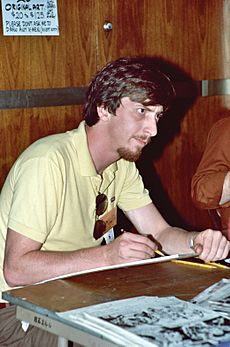
In May 1979, Miller started working on Daredevil with issue #158. Sales for the comic quickly improved, and Miller soon became both the writer and artist for the series starting with issue #168 in January 1981. He introduced new characters like Elektra, a ninja mercenary who became very popular. He also added martial arts to Daredevil's fighting style and introduced the ninja clans, the Chaste and the Hand.
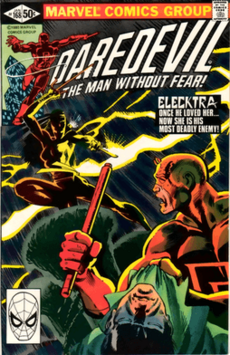
Miller's stories for Daredevil became darker and more serious. He finished his run on Daredevil with issue #191 in February 1983. By then, he had turned a less popular character into one of Marvel's most famous.
Other Early Works
Miller also drew a short Batman Christmas story for DC Comics in 1980. This was his first time working on Batman, a character he would become very famous for. With writer Chris Claremont, Miller also created the miniseries Wolverine #1–4 in 1982. This series helped make Wolverine an even more popular character.
His first comic series where he owned the rights to his creations was DC Comics' six-issue miniseries Ronin (1983–1984). In 1985, DC Comics honored Miller as one of the "Fifty Who Made DC Great" for their 50th anniversary.
Batman: The Dark Knight Returns
In 1986, Frank Miller wrote and drew Batman: The Dark Knight Returns for DC Comics. This four-issue series was printed in a special "prestige format" with high-quality paper. The story shows Batman, at 55 years old, coming out of retirement to fight crime in a dark and violent future. Miller made Batman a tough and gritty hero, often called "The Dark Knight."
This series, along with Watchmen by Alan Moore, changed comic books by showing that they could tell more mature and serious stories. The Dark Knight Returns was very influential and is still a popular comic today.
Born Again and Batman: Year One
Miller also returned to write Daredevil with artist David Mazzucchelli. They created a seven-issue story called "Daredevil: Born Again" (1986). This story explored Daredevil's background and showed how his secret identity was destroyed and then rebuilt.
Miller and Mazzucchelli worked together again on Batman issues #404–407 in 1987. This story, called Batman: Year One, told Miller's version of Batman's origin story. It was very popular and influential, and it was even made into an animated film in 2011.
Miller also helped bring Japanese manga to a wider audience in the West by illustrating covers for the English reprints of Lone Wolf and Cub.
The 1990s: Sin City and 300
In the 1990s, Miller started working mainly with the independent publisher Dark Horse Comics. He created Elektra Lives Again, a painted graphic novel about Elektra's return.
In 1990, Miller and artist Geof Darrow started Hard Boiled, a three-issue series known for its detailed art and action. Miller also worked with artist Dave Gibbons on Give Me Liberty, a four-issue series about a character named Martha Washington.
Miller wrote the scripts for the science fiction films RoboCop 2 and RoboCop 3. He also wrote the comic book miniseries RoboCop Versus The Terminator.
In 1991, Miller began his Sin City stories. These stories were very successful and helped bring back the crime comics genre. Sin City became Miller's main project for many years, and he created many stories set in this dark, noir world. Miller lived in Los Angeles and later Hell's Kitchen in New York City, which influenced his Sin City stories.
Miller also returned to superheroes by writing Spawn #11 and the Spawn/Batman crossover comic. In 1994, he became a founding member of the comic imprint Legend, which released many of his Sin City works.
300 was a comic book miniseries written and illustrated by Miller, with colors by Lynn Varley. It was released in 1998 and told the story of the Battle of Thermopylae from the perspective of Leonidas of Sparta. Miller was inspired by the 1962 film The 300 Spartans when he was a boy.
The 2000s and Beyond
In 2001, Miller released Batman: The Dark Knight Strikes Again, a sequel to The Dark Knight Returns. He also wrote All Star Batman & Robin, the Boy Wonder in 2005.
Miller's view on movie adaptations changed after director Robert Rodriguez made a short film based on a Sin City story. Miller liked it so much that he and Rodriguez co-directed a full-length film, Sin City, released in 2005. The film used Miller's original comic panels as storyboards. This movie's success brought more attention to Miller's Sin City comics. In 2006, a film adaptation of 300, directed by Zack Snyder, also brought new attention to Miller's original comic book. A sequel to the film, Sin City: A Dame to Kill For, co-directed by Miller and Robert Rodriguez, was released in 2014.
In July 2015, Miller was inducted into the Eisner Awards Hall of Fame. From 2015 to 2017, DC Comics released The Dark Knight III: The Master Race, a sequel to his earlier Batman stories. Miller co-wrote it with Brian Azzarello. In 2016, Miller and Azzarello also co-wrote the graphic novel The Dark Knight Returns: The Last Crusade.
From April to August 2018, Dark Horse Comics published Miller's five-issue miniseries Xerxes: The Fall of the House of Darius and the Rise of Alexander, which was his first work as both writer and artist since Holy Terror.
In 2017, Miller announced a Superman: Year One project, which was released by DC Black Label from June to October 2019. He also co-wrote a young-adult novel called Cursed with author Tom Wheeler in October 2019. This book tells the King Arthur legend from the point of view of the Lady of the Lake. In December 2019, DC released Dark Knight Returns: The Golden Child, the fifth series in The Dark Knight Returns universe.
Recent Projects (2020s)
In July 2020, Netflix released a 10-episode series based on Cursed, with Miller and Wheeler as creators and executive producers.
In April 2022, it was announced that Miller was starting his own comic book publishing company called Frank Miller Presents (FMP). Miller is the company's president and editor-in-chief. FMP plans to release new titles each year, including Sin City 1858 and Ronin Book Two. As of November 2023, FMP was also working on Pandora, a fantasy adventure series.
A documentary film about Frank Miller, titled Frank Miller: American Genius, premiered in June 2024.
Personal Life
Frank Miller was married to colorist Lynn Varley from 1986 to 2005. She colored many of his famous works, including Ronin and 300. Miller has described himself as an atheist. He also identifies as a libertarian.
Art Style and Influence
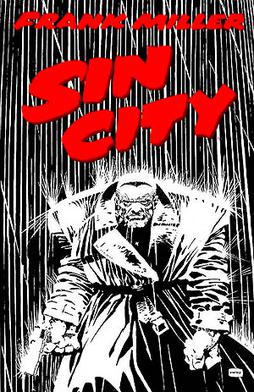
Frank Miller's art style is unique. When he started on Daredevil, he added a film noir feel to the comic. He would sketch New York City rooftops to make his art feel more real. His Daredevil stories often took place on rooftops, with water towers and chimneys creating dramatic shadows, similar to German Expressionism art.
His comic Ronin shows strong influences from manga and bande dessinée in both its art and storytelling. Sin City was drawn in black and white to highlight its film noir roots. Miller believes that superheroes work best as exciting fantasies. He doesn't think they need to look completely realistic.
Miller considers the Argentinian comic artist Alberto Breccia as a mentor. Miller's work in Sin City has been compared to Breccia's style, especially his use of strong black-and-white contrasts.
Impact and Reception
Daredevil: Born Again and The Dark Knight Returns were very successful and influenced many comic creators who came after Miller. They are considered classic comic books. Batman: Year One was also praised for its tough style. Comics like Ronin, 300, and Sin City were also popular, making Miller a legend in the comic book world.
His film adaptation of Sin City was well-received by audiences and critics. It was praised for bringing the dark world of his graphic novel to life.
Awards and Nominations
Frank Miller has received many awards for his work:
Inkpot Awards
- Received an Inkpot Award – 1981
Kirby Awards
- Best Single Issue –
- 1986 Daredevil #227 "Apocalypse" (Marvel)
- 1987 Batman: The Dark Knight Returns #1 "The Dark Knight Returns" (DC)
- Best Writer/Artist (single or team) – 1986 Frank Miller and David Mazzucchelli, for Daredevil: Born Again (Marvel)
- Best Graphic Album, 1987 Batman: The Dark Knight Returns (DC)
- Best Art Team – 1987 Frank Miller, Klaus Janson and Lynn Varley, for Batman: The Dark Knight Returns (DC)
- Best Writer/Artist —
- 1991 for Elektra Lives Again (Marvel)
- 1993 for Sin City (Dark Horse)
- 1999 for 300 (Dark Horse)
- Best Graphic Album: New – 1991 Elektra Lives Again (Marvel)
- Best Finite Series/Limited Series —
- 1991 Give Me Liberty (Dark Horse)
- 1995 Sin City: A Dame to Kill For (Dark Horse/Legend)
- 1996 Sin City: The Big Fat Kill (Dark Horse/Legend)
- 1999 300 (Dark Horse)
- Best Graphic Album: Reprint —
- 1993 Sin City (Dark Horse)
- 1998 Sin City: That Yellow Bastard (Dark Horse)
- Best Artist/Penciller/Inker or Penciller/Inker Team – 1993 for Sin City (Dark Horse)
- Best Short Story – 1995 "The Babe Wore Red", in Sin City: The Babe Wore Red and Other Stories (Dark Horse/Legend)
- Eisner Awards Hall Of Fame, 2015
Harvey Awards
- Best Continuing or Limited Series –
- 1996 Sin City (Dark Horse)
- 1999 300 (Dark Horse)
- Best Graphic Album of Original Work – 1998 Sin City: Family Values (Dark Horse)
- Best Domestic Reprint Project – 1997 Batman: The Dark Knight Returns, 10th Anniversary Edition (DC)
Eagle Awards
- Favourite Comicbook Pencil Artist — 1983
- Favourite Comicbook Writer: U.S. — 1986
- Roll of Honour — 1987
- Favourite Comicbook Pencil Artist — 1987
- Favourite Comic Album: U.S. — 1987 Batman: The Dark Knight Returns (DC)
- Favourite Cover: U.S. — 1987 Batman: The Dark Knight Returns #1 (DC)
- Favourite Comic Album: US — 1988 Daredevil: Love and War (DC)
- Favourite Black & White Comicbook — 2000 Hell and Back (A Sin City Love Story) (Dark Horse)
- Favourite Comics Writer/Artist — 2002
- Favourite Comics-Related Book — 2006 Eisner/Miller (Dark Horse)
- Favourite Comics Writer/Artist — 2012
UK Comic Art Award
- Best Original Graphic Novel/One-Shot — 1991 Elektra Lives Again (Epic Comics)
- Best Writer/Artist — 1992
- Best Writer/Artist — 1993
- Best Graphic Novel Collection — 1993 Sin City
- Best Writer/Artist — 1994
- Palme d'Or – 2005 (nominated) Sin City (Dimension Films)
Scream Awards
- The Comic-Con Icon Award – 2006
Filmography
Films
| Year | Title | Director | Screenwriter | Executive Producer | Actor | Role | Notes |
|---|---|---|---|---|---|---|---|
| 1990 | RoboCop 2 | No | Yes | No | Uncredited | Frank, the Chemist | |
| 1993 | RoboCop 3 | No | Yes | No | No | N/A | |
| 2003 | Daredevil | No | No | No | Yes | Man with Pen in Head | Also inspired by his graphic novels |
| 2005 | Sin City | Yes | Uncredited | No | Yes | The Priest | Also based on his graphic novel Co-directed with Robert Rodriguez |
| 2006 | 300 | No | No | Yes | No | N/A | Also based on his graphic novels |
| 2008 | The Spirit | Yes | Yes | No | Yes | Liebowitz | |
| 2014 | 300: Rise of an Empire | No | No | Yes | No | N/A | Also based on his graphic novels |
| Sin City: A Dame to Kill For | Yes | Yes | Yes | Uncredited | Sam | Also based on his graphic novels Co-directed with Robert Rodriguez |
Television
| Year | Title | Creator | Executive Producer | Actor | Role | Notes |
|---|---|---|---|---|---|---|
| 2020 | Cursed | Yes | Yes | Yes | Brother Horde | Based on his novel |
See also
 In Spanish: Frank Miller para niños
In Spanish: Frank Miller para niños


